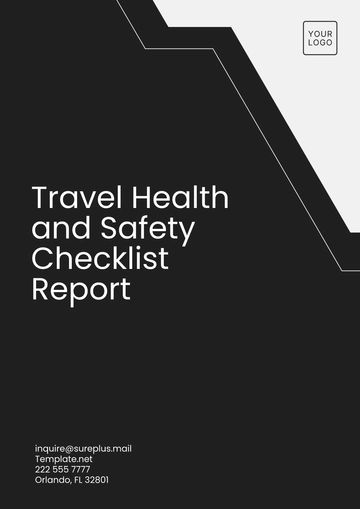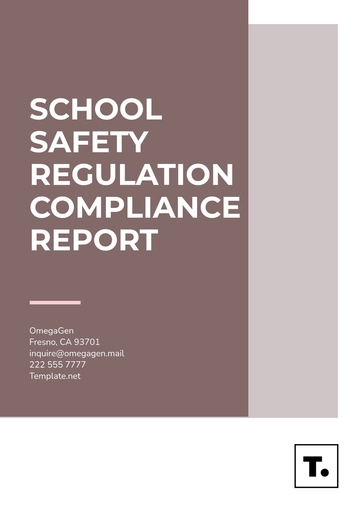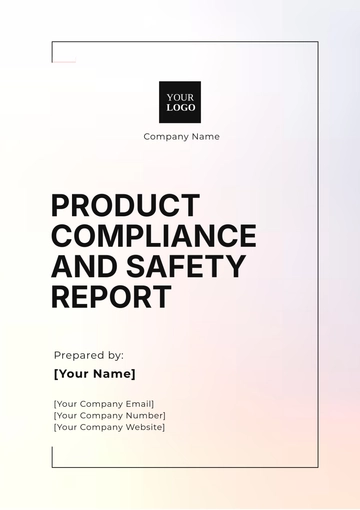Free Restaurant Safety Report

I. Executive Summary
This Restaurant Safety Report provides a comprehensive overview of our current safety practices, audit results, and incident analysis. The purpose of this report is to evaluate our safety measures, identify areas for improvement, and implement effective strategies to enhance safety within our establishment. Through rigorous audits and incident analysis, we have identified key findings and developed recommendations to ensure a safe environment for both employees and customers.
Audit Findings
Area | Critical Violations | Non-Critical Violations |
|---|---|---|
Kitchen | 5 | 3 |
Dining Area | 2 | 1 |
Storage | 3 | 2 |
Restrooms | 1 | 0 |
Incident Analysis
4 incidents: 2 slips, 1 foodborne illness, and 1 equipment-related injury
Root causes identified include inadequate staff training and equipment maintenance issues
II. Introduction
Our restaurant has been serving the community for over five years, providing high-quality dining experiences with a focus on safety and customer satisfaction. The objective of this safety report is to assess our current safety practices, identify any areas of non-compliance or risk, and recommend actions to improve our safety standards. Ensuring a safe environment is paramount to protecting our employees and customers and maintaining our reputation as a trusted dining establishment.
III. Safety Audit and Inspection Results
Our safety audit and inspection process involved a thorough review of all areas within the restaurant, including the kitchen, dining area, storage, and restrooms. The audit was conducted by our internal safety team, who used a standardized checklist to evaluate compliance with health and safety regulations.
Area | Critical Violations | Non-Critical Violations |
|---|---|---|
Kitchen | 5 | 3 |
Dining Area | 2 | 1 |
Storage | 3 | 2 |
Restrooms | 1 | 0 |
A. Kitchen
The kitchen audit revealed five critical violations and three non-critical violations. Critical violations included improper food storage temperatures, inadequate handwashing facilities, and poor sanitation practices. Non-critical violations involved minor equipment maintenance issues and general cleanliness.
B. Dining Area
The dining area audit identified two critical violations and one non-critical violation. Critical violations included obstructed emergency exits and inadequate lighting. The non-critical violation was related to minor cleanliness issues.
C. Storage
The storage area audit found three critical violations and two non-critical violations. Critical violations included expired food products, improper labeling, and inadequate pest control measures. Non-critical violations involved organization and accessibility of stored items.
D. Restrooms
The restroom audit uncovered one critical violation and no non-critical violations. The critical violation was related to insufficient handwashing supplies and facilities.
IV. Incident Analysis
During the reporting period, we recorded four significant incidents. Each incident was thoroughly investigated to determine root causes and implement corrective actions.
Incident Type | Number of Occurrences |
|---|---|
Slips | 2 |
Foodborne Illness | 1 |
Equipment-Related Injury | 1 |
A. Slip and Fall Incident
Two slip and fall incidents occurred in the kitchen area due to wet and greasy floors. Both incidents resulted in minor injuries to employees. The root cause analysis identified inadequate floor cleaning procedures and lack of non-slip mats as contributing factors.
B. Foodborne Illness Incident
One customer reported a foodborne illness after dining at our restaurant. An investigation revealed that improper food handling and storage practices were likely responsible for the contamination. The root cause was traced to insufficient staff training on food safety protocols.
C. Equipment-Related Injury
An equipment-related injury occurred when an employee was using a malfunctioning meat slicer. The investigation found that the equipment had not been properly maintained, leading to the accident. The root cause was identified as a lack of regular equipment maintenance and inspections.
V. Health and Safety Procedures
Our current health and safety procedures are designed to maintain a safe and healthy environment for employees and customers. These procedures cover a range of areas including food handling, sanitation, equipment usage, and emergency preparedness. Regular evaluations are conducted to assess the effectiveness of these procedures and identify areas for improvement.
Procedure | Effectiveness Rating (1-5) |
|---|---|
Food Handling and Storage | 3 |
Cleaning and Sanitation | 4 |
Pest Control | 3 |
Equipment Maintenance | 2 |
Fire Safety | 4 |
Emergency Procedures | 4 |
PPE Usage | 3 |
Our evaluations indicate that while many of our health and safety procedures are generally effective, there are several areas requiring improvement. Recommendations include enhancing food handling training to ensure proper temperature control, increasing the frequency of pest control measures, implementing a more rigorous equipment maintenance schedule, and conducting regular fire drills to ensure staff readiness. Additionally, promoting consistent use of personal protective equipment (PPE) among all staff members is crucial.
VI. Employee Training and Awareness
Employee training and awareness are critical components of our health and safety program. Regular training sessions are conducted to ensure all employees are knowledgeable about safety protocols and procedures. The effectiveness of these training programs is evaluated based on participation rates and post-training assessments.
Program | Participation Rate (%) | Evaluation Score (1-5) |
|---|---|---|
Food Handling and Safety | 95 | 4 |
Cleaning and Sanitation | 90 | 4 |
Fire Safety and Emergency Procedures | 85 | 4 |
Equipment and Machinery Safety | 80 | 3 |
Personal Protective Equipment (PPE) | 75 | 3 |
Mental Health Awareness | 70 | 3 |
Our training programs generally have high participation rates and good evaluation scores. However, there is room for improvement in areas such as equipment and machinery safety, PPE usage, and mental health awareness. Future training plans include increasing the frequency of these sessions, incorporating hands-on practice, and providing more comprehensive mental health support training. Ensuring all employees complete these programs will enhance overall safety and awareness.
VII. Equipment and Facility Safety
Ensuring the safety of our equipment and facilities is essential for preventing accidents and maintaining a safe working environment. Regular inspections are conducted to identify any potential hazards, and corrective actions are implemented promptly.
Identified Hazard | Location |
|---|---|
Malfunctioning meat slicer | Kitchen |
Wet floors causing slips | Kitchen |
Insufficient handwashing facilities | Restrooms |
Obstructed emergency exits | Dining area |
Poor lighting | Dining area |
Corrective actions for identified hazards include repairing and maintaining equipment, improving cleaning procedures to prevent slips, enhancing handwashing facilities, clearing and marking emergency exits, and upgrading lighting. These measures help mitigate risks and ensure a safer environment for both employees and customers.
VIII. Compliance and Legal Requirements
Compliance with relevant health and safety regulations is crucial for maintaining legal and operational standards. We regularly review and update our practices to ensure full compliance with all applicable laws and regulations.
Regulation | Compliance Status |
|---|---|
Occupational Safety and Health Act (OSHA) | Compliant |
Food Safety Modernization Act (FSMA) | Mostly compliant |
Americans with Disabilities Act (ADA) | Compliant |
Fair Labor Standards Act (FLSA) | Compliant |
Family and Medical Leave Act (FMLA) | Compliant |
Clean Air Act (CAA) | Compliant |
Resource Conservation and Recovery Act (RCRA) | Compliant |
We are generally compliant with all relevant regulations, though there are areas such as temperature control under FSMA where we need to make minor improvements. Continuous monitoring and updating of our practices ensure we meet all legal requirements and maintain a safe environment.
IX. Customer Safety and Feedback
Ensuring customer safety is a top priority, and we regularly collect and analyze feedback to identify any potential safety issues and areas for improvement. Customer feedback is gathered through comment cards, online reviews, and direct communication with staff. This feedback is used to make necessary adjustments and enhance the overall safety and experience for our patrons.
Common Feedback Themes | Frequency |
|---|---|
Cleanliness and hygiene | High |
Prompt response to safety concerns | Medium |
Adequate lighting in dining area | Low |
Safe and accessible facilities | Medium |
Emergency procedures awareness | Low |
One customer safety incident involved a slip and fall in the dining area due to a wet floor. The customer reported the incident immediately, and our staff provided prompt assistance and medical attention. An investigation revealed that the floor had been recently mopped but not adequately dried. To prevent similar incidents, we have implemented the following measures:
Improved floor drying procedures to ensure no wet spots are left unattended.
Placed clear signage to warn customers of wet floors.
Provided additional training for staff on proper cleaning and safety protocols.
X. Monitoring and Review
Ongoing monitoring and regular reviews are essential to ensure the effectiveness of our health and safety measures. We have established key performance indicators (KPIs) to track our progress and identify areas for continuous improvement. These KPIs are reviewed regularly to ensure we meet our safety targets.
Metric | Target Value |
|---|---|
Number of incidents | 0 per quarter |
Employee training completion rate | 100% |
Customer satisfaction (safety-related) | 95% positive |
Equipment maintenance compliance | 100% |
Health and safety audit scores | 90% or above |
Reviews and updates will occur quarterly, with the safety committee meeting to analyze the collected data and compare it to our target values. The committee will include management, safety officers, and employee representatives to ensure a comprehensive evaluation. Any necessary adjustments to our safety procedures will be made based on the findings, and updates will be communicated to all staff members.
XI. Conclusion
Our commitment to maintaining the highest standards of health and safety is unwavering. By continuously monitoring our practices, addressing customer and employee feedback, and implementing necessary improvements, we strive to provide a safe and welcoming environment for everyone. Let us all remain vigilant and proactive in our efforts to uphold these standards and ensure the well-being of our community.
- 100% Customizable, free editor
- Access 1 Million+ Templates, photo’s & graphics
- Download or share as a template
- Click and replace photos, graphics, text, backgrounds
- Resize, crop, AI write & more
- Access advanced editor
The editable and customizable Restaurant Safety Report Template from Template.net allows you to document and analyze safety practices in your restaurant. Monitor incidents, evaluate safety procedures, and implement improvements. Editable in our AI Editor tool, this template helps you create detailed reports that ensure a safe environment for both employees and customers.
You may also like
- Sales Report
- Daily Report
- Project Report
- Business Report
- Weekly Report
- Incident Report
- Annual Report
- Report Layout
- Report Design
- Progress Report
- Marketing Report
- Company Report
- Monthly Report
- Audit Report
- Status Report
- School Report
- Reports Hr
- Management Report
- Project Status Report
- Handover Report
- Health And Safety Report
- Restaurant Report
- Construction Report
- Research Report
- Evaluation Report
- Investigation Report
- Employee Report
- Advertising Report
- Weekly Status Report
- Project Management Report
- Finance Report
- Service Report
- Technical Report
- Meeting Report
- Quarterly Report
- Inspection Report
- Medical Report
- Test Report
- Summary Report
- Inventory Report
- Valuation Report
- Operations Report
- Payroll Report
- Training Report
- Job Report
- Case Report
- Performance Report
- Board Report
- Internal Audit Report
- Student Report
- Monthly Management Report
- Small Business Report
- Accident Report
- Call Center Report
- Activity Report
- IT and Software Report
- Internship Report
- Visit Report
- Product Report
- Book Report
- Property Report
- Recruitment Report
- University Report
- Event Report
- SEO Report
- Conference Report
- Narrative Report
- Nursing Home Report
- Preschool Report
- Call Report
- Customer Report
- Employee Incident Report
- Accomplishment Report
- Social Media Report
- Work From Home Report
- Security Report
- Damage Report
- Quality Report
- Internal Report
- Nurse Report
- Real Estate Report
- Hotel Report
- Equipment Report
- Credit Report
- Field Report
- Non Profit Report
- Maintenance Report
- News Report
- Survey Report
- Executive Report
- Law Firm Report
- Advertising Agency Report
- Interior Design Report
- Travel Agency Report
- Stock Report
- Salon Report
- Bug Report
- Workplace Report
- Action Report
- Investor Report
- Cleaning Services Report
- Consulting Report
- Freelancer Report
- Site Visit Report
- Trip Report
- Classroom Observation Report
- Vehicle Report
- Final Report
- Software Report





























